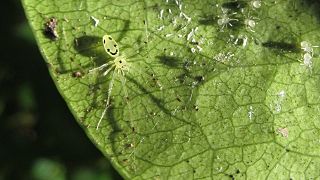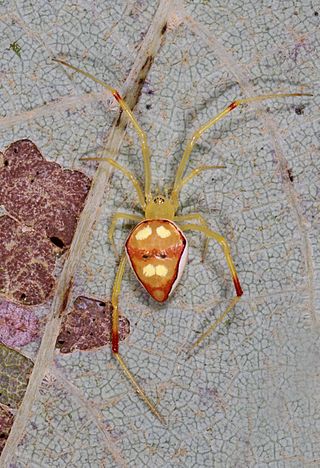
Theridiidae, also known as the tangle-web spiders, cobweb spiders and comb-footed spiders, is a large family of araneomorph spiders first described by Carl Jakob Sundevall in 1833. This diverse, globally distributed family includes over 3,000 species in 124 genera, and is the most common arthropod found in human dwellings throughout the world.

Eresus, also called ladybird spiders, is a genus of velvet spiders that was first described by Charles Athanase Walckenaer in 1805. Members of the genus formerly called Eresus cinnaberinus or Eresus niger are now placed in one of three species: Eresus kollari, Eresus sandaliatus and Eresus moravicus.

Theridion grallator, also known as the Hawaiian happy-face spider, is a spider in the family Theridiidae that resides on the Hawaiian Islands. T. grallator gets its vernacular name of "Hawaiian happy-face spider" from the unique patterns superimposed on its abdomen, specifically those that resemble a human smiling face. T. grallator is particularly notable because of its wide range of polymorphisms that may be studied to allow a better understanding of evolutionary mechanisms. In addition to the variety of color polymorphisms present, T. grallator demonstrates the interesting quality of diet-induced color change, in which its appearance temporarily changes as it metabolizes various food items.

Theridion is a genus of tangle-web spiders with a worldwide distribution. Notable species are the Hawaiian happy face spider (T. grallator), named for the iconic symbol on its abdomen, and T. nigroannulatum, one of few spider species that lives in social groups, attacking prey en masse to overwhelm them as a team.

The spider genus Spintharus occurs from the northeastern United States to Brazil. Nicholas Marcellus Hentz circumscribed the genus in 1850, initially as a monospecific genus containing his newly described species S. flavidus.
Paratheridula is a monotypic genus of comb-footed spiders containing the single species, Paratheridula perniciosa. The sole species was first described in 1886 under the name Theridion perniciosum. The genus was first described by Herbert Walter Levi in 1957, though it has been described under several different names, including Mysmena 4-maculata, Theridion quadrimaculatum, and Theridion arcadicum,

Theridula is a genus of cobweb spiders, found in many parts of the world. Species vary in size from 1 to 3.5 mm in length.

Rugathodes is a genus of comb-footed spiders that was first described by Allan Frost Archer in 1950. It is closely related to members of Theridion and Wamba.
Carniella is a genus of comb-footed spiders that was first described by K. Thaler & K.-H. Steinberger in 1988.

Lasaeola is a genus of comb-footed spiders that was first described by Eugène Louis Simon in 1881. The type species was described under the name Pachydactylus pronus, but was renamed Lasaeola prona when it was discovered that the name "Pachydactylus" was preoccupied. Both this genus and Deliana were removed from the synonymy of Dipoena in 1988, but many of these species require more study before their placement is certain.

Phylloneta is a genus of comb-footed spiders formerly considered a sub-genus of Allotheridion, and raised to genus status in 2008. The type species was first described by Eugen von Keyserling in 1884 as Theridion pictipes. As of September 2019 it contains three species and two subspecies with a holarctic distribution: P. impressa, P. pictipes, P. sisyphia, P. s. foliifera, and P. s. torandae.
Pulchellodromus is a genus of running crab spiders that was first separated from Philodromus by J. Wunderlich in 2012.
Panamomops is a genus of dwarf spiders that was first described by Eugène Louis Simon in 1884.

Canalidion is a monotypic genus of tangle-web spiders containing the single species, Canalidion montanum. The species was first described by James Emerton in 1882 under the name Theridion montanum. J. Wunderlich moved it to its own genus in 2018, because it had more teeth on the anterior margin of the cheliceral furrow, a basal depression of the cymbium, and an embolus positioned dorsally. It has a holarctic distribution.
Jamaitidion is a monotypic genus of comb-footed spiders containing the single species, Jamaitidion jamaicense. The genus was first described by J. Wunderlich in 1995, and is found on the Greater Antilles. The sole species of this genus was described by Herbert Walter Levi in 1959. It was originally placed in Theridion, but was moved to its own genus based on unique features of the epigynum.

Ohlertidion is a genus of comb-footed spiders that was first described by J. Wunderlich in 2008. As of September 2019 it contains three species with a holarctic distribution, including Greenland: O. lundbecki, O. ohlerti, and O. thaleri. A 2019 genetic study proposed to synonymize this genus with Heterotheridion; however, the evidence was based predominantly on COI barcoding, which is a useful tool for separating species, but is less useful for determining higher taxa.

Paidiscura is a genus of comb-footed spiders that was first described by Allan Frost Archer in 1950.
Sardinidion is a monotypic genus of comb-footed spiders containing the single species, Sardinidion blackwalli. It was first described by J. Wunderlich in 1995, and is found in Africa and Europe.

Simitidion is a genus of comb-footed spiders that was first described by J. Wunderlich in 1992. As of June 2020 it contains three species, native to Africa, Asia and Europe, and introduced to Canada: S. agaricographum, S. lacuna, and S. simile.
Theonoe is a genus of comb-footed spiders that was first described by Eugène Louis Simon in 1881.













